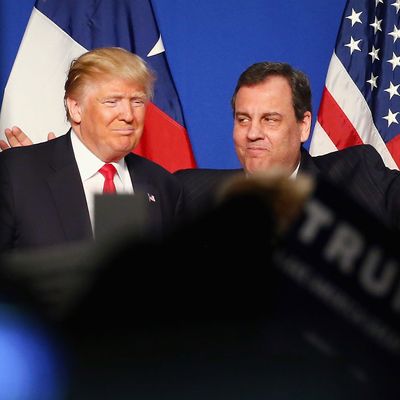
When you look at the two of them on the surface, Donald Trump and Chris Christie look a lot alike. They are blustering northeastern Republicans with a bullying style that substitutes for a lack of conventionally attractive communication skills. When you look a bit beneath the surface, they diverge: Christie is a doctrinaire neoconservative on foreign policy and an ally of the donor class on trade and retirement programs who has eloquently defended Muslim rights. Trump has attacked neoconservative shibboleths in shockingly blunt terms, alienated Republican donors by embracing crude protectionism, promised not to touch retirement spending, and steeped himself in anti-Muslim bigotry. But then, when you look even further beneath the surface, you can see that Christie and Trump actually do resemble each other after all.
The best way to understand Christie is to read Alec MacGillis’s profile of him from two years ago. MacGillis’s thesis is that Christie, who posed as a reformer, was in fact a master of New Jersey’s crooked machine. He rose to power under the guise of cleaning out its corruption, but actually shoved aside the competition so he could take over the rackets for himself. To understand Christie in ideological terms is to miss the point about him. He’s a throwback to a figure from the pre-polarized era, the machine pol.
The machine pol has his good sides. He would accept Obamacare’s Medicaid expansion because he would not dream of turning down free money for his state for ideological reasons. If he could bolster his sagging popularity by publicly embracing a Democratic president before his reelection, he would do so. A lack of principles, in these cases, drives him toward more attractive behavior than a politician filled with ugly principles. By the same token, his methods can be ugly, corrupt, and undemocratic.
That holds true for Trump as well. The still-forming portrait of Trump as a politician increasingly crystallized his fixation on deal-making as the highest end. He does not oppose free trade so much as he wants to make different and better deals. Trump boasts that he is well-liked and can make deals with anybody. At the last debate, his praise for deal-making absorbed the withering incomprehension of Ted Cruz, who has made opposition to deal-making in all its forms the foundation of his career.
At one point Trump boasted:
I’ve had an amazing relationship with politicians – with politicians both Democrat, Republican, because I was a businessman. As one magazine said, he’s a world-class businessman; he was friendly with everybody. I got along with everybody.
Cruz shot back:
You know, I actually think Donald is right. He is promising if he’s elected he will go and cut deals in Washington. And he’s right. He has supported – he has given hundreds of thousands of dollars to Democrats. Anyone who really cared about illegal immigration wouldn’t be hiring illegal immigrants. Anyone who really cared about illegal immigration wouldn’t be funding Harry Reid and Nancy Pelosi; wouldn’t be funding the Gang of Eight. And, you know, he is right. When you stand up to Washington, when you honor the promise you made to the men and women who elected you and say enough with the corruption, enough with the cronyism, let’s actually stand for the working men and women of this country, Washington doesn’t like it.
And Donald, if you want to be liked in Washington, that’s not a good attribute for a president.
For Christie, the logic could not be more simple. Trump is his party’s front-runner. If another candidate held that position, Christie would be dealing with him. Trump and Christie are both figures whose self-interest aligned, and whose most important worldviews aligned as well. The deal-makers made a deal.






























